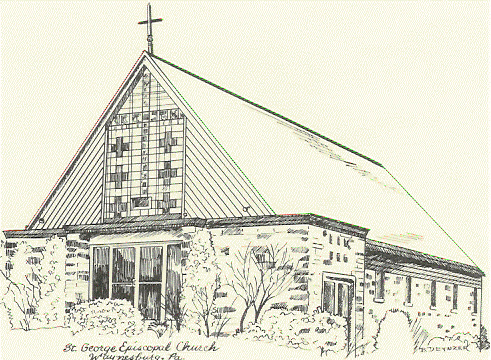Sometimes the light shines a little late.
I had finally tracked down a contact number for St. George’s Episcopal Church, that handsome little edifice at the corner of Bonar Avenue and Fifth Street, Waynesburg. I was eager to hear the story of when this church, with its deep roots in Anglican tradition, was built and learn the story of its founding. Deaconess Barbara McMillen’s cheery hello when I called didn’t prepare me for the answer I was about to receive.
“Oh I wish I would have contacted you last year to write about St. George! We just closed in October. Our numbers were down, our congregation is elderly and when the pandemic came no one could go to church… so we decided to close. It’s so sad. There’s no other Episcopal churches in Greene County to go to now.”
What sets these Anglican-based churches apart from other Protestant offshoots is the worship service, which is old school. The service goes back to King Henry VIII of England who broke from the Catholic Church over politics but kept many of the trappings of high mass – the incense, the ringing bells, the songs, the same Church of England service Queen Elizabeth still attends. I’m sorry I missed going there.
My story has now become a celebration of the faith of the Elms family, told in the church records Deaconess Barbara emailed me from her winter digs in Florida.
Here’s the serendipitous tale of how George Elms got to Greene County and what he and his family did to keep their old world faith alive.
When George Elms married Sarah Jones at St. Paul’s Church in Birmingham, England in 1852, he and his brother Charlie decided it would be a good idea to move to the United States. Charlie left his betrothed and went first and “somehow ended up picking a spot for the family in Swarts…” a settlement a few miles north of Waynesburg.
Two years later, George and Sarah and firstborn son Jack, along with Charlie’s fiancée took to the high seas in an old fashioned sailing vessel and arrived in Philadelphia six weeks later. They traveled by coach to Pittsburgh then took a boat to Rices Landing. With 25 cents left, George arranged for the family to ride in a wagon to Swarts and followed behind on foot.
George served in the Union Army during the Civil War while Sarah worked for Iams and Harvey to feed the family; George never received a paycheck until the war was over. But his lump sum commission of $1000 bought them a house on Franklin Street and the family moved to Waynesburg. By 1886 George was determined to have his ten now-adult children baptized so he wrote to the Diocese of Pittsburgh and Bishop Whitehead came and baptized and confirmed the family. “This event started the gathering of Episcopalians in Greene County and St. George’s mission of the Protestant Episcopal Church of Waynesburg.”
There were services and Sunday School classes at the Elms home, mostly family members, in-laws and friends. By 1904 the mission bought a lot on Porter Street and worshiped in a tent with a raised floor and an elevated alter with the American Flag and the Church flag suspended from the ceiling on either side. “An organ was provided and no service went without lively music.” It was the height of vacation time and within three weeks Waynesburg and the local press took note of the town’s new mission.
By 1908 the St. George had its first permanent home in the East Waynesburg School. A mission that had disbanded gave furnishings. There would be more moves but the Elms house was always waiting and when George and Sarah died, daughter Lizzie inherited the house and its commitment to St. George, patron saint of England.
When Lizzie died in 1956, she left the congregation her home and $8000. The membership pooled its resources, including selling the lot on Porter Street and bought a lot on Bonar Avenue from Dr. Greenlee. The cornerstone was set in 1960 and on November 5, 1961, St. George’s Episcopal Church finally had a home.
A write up from 1986 shows that St. George’s knew its neighbors and knew what they needed. “We were the first to begin bus transportation for senior citizens in Waynesburg.” The church also started the first AA group and opened its doors to play groups, praise groups, vacation bible school and Overeaters Anonymous. Hospice trainings were held here and space was always available to those who had friends or family members in nearby Waynesburg Hospital and needed a place to pray, meditate or even stay over.
An addendum to the write up says that in 2009 the congregation voted unanimously to join the Anglican Church of North America and continued to worship, pray for and serve the Greene County community.
Deaconess Barbara adds that the remaining members of the congregation continue to pray for, love and care for each other. The building and property have reverted to the Episcopal Diocese of Pittsburgh.
